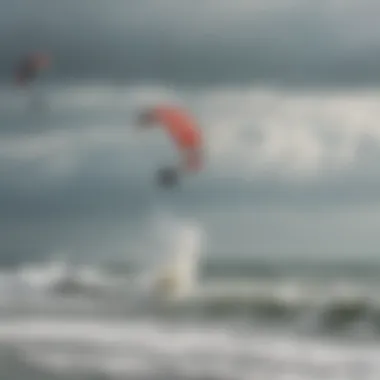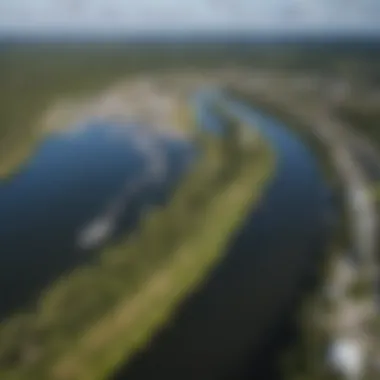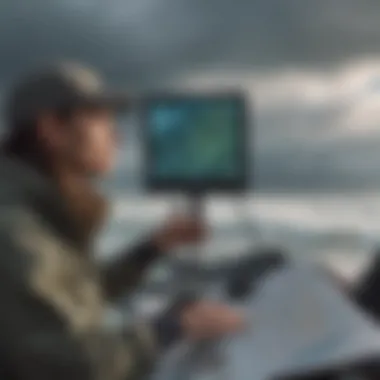Understanding Weather Radar for Kiteboarding Safety


Intro
Weather radar plays a crucial role in helping residents of New Port Richey, Florida, stay aware of their local weather conditions. Being situated on the Gulf Coast, this area faces a unique set of meteorological challenges. From sudden thunderstorms to quiet sunny afternoons, understanding how weather radar operates can provide key insights into forecasting. The local kiteboarding community particularly benefits from these advancements, as weather radar helps ensure safe conditions for a thrilling day on the water.
By breaking down how these systems work, recent technological advancements, and their specific implications for outdoor activities like kiteboarding, this article aims to serve as both an informative guide and a resource.
Additionally, it will touch on environmental factors that play a significant role in the area's weather patterns, aiding readers—whether they are seasoned meteorologists or weekend adventurers—by providing a clearer picture of weather expectations.
Gear Insights
Latest Gear Reviews
Understanding what gear is essential can dramatically enhance your kiteboarding experience. In New Port Richey, the right equipment ensures you take advantage of favorable weather without compromising safety. Recently, models such as the Duotone Evo and the Naish Pivot have garnered positive attention. These kites are praised for their versatility and performance in varying conditions, making them solid choices for both novices and experienced riders.
- Duotone Evo: Ideal for all skill levels, offering stability and ease of use, which is essential for beginners.
- Naish Pivot: Known for its responsiveness and lift, catering to those looking to master advanced maneuvers.
Essential Gear for Beginners
For those just dipping their toes into kiteboarding, having the right gear can make all the difference. Here are some essential items for beginners navigating the breezy waters of the Gulf:
- Kite: Choose a kite that matches the wind conditions. A smaller kite is easier to handle for those learning basic skills.
- Board: A wide board provides better stability while you’re getting your sea legs.
- Safety Gear: Always wear a life jacket and a helmet for safety. High winds can catch even the most seasoned kiteboarders off guard.
"Invest in good equipment, and you'll enjoy a lot more fun out on the water."
Techniques and Tips
Advanced Tricks and Techniques
For those looking to step up their game, progression in kiteboarding can mean tackling tricks. Learning jumps like the kite loop can create powerful moments on the water, but it does require practice and awareness of your surroundings. Monitoring real-time weather radar can provide insights into sudden wind changes or inclement weather to avoid dangerous situations.
Safety Practices for Kiteboarders
Safety should never take a backseat, particularly in areas prone to sudden weather shifts. Here are several practices to keep in mind:
- Stay Informed: Regularly check the weather radar and forecasts before heading out. This information is vital for timing your sessions.
- Communicate: Always inform someone about your kiteboarding plans and expected return time.
- Buddy System: Try not to ride alone. Having a partner can enhance safety, as someone is there to offer help if you run into trouble.
Prologue to Weather Radar
In the grand tapestry of meteorology, weather radar serves as a crucial thread that weaves information about atmospheric conditions. The effective use of radar technology has about streamlined the way we perceive and react to weather phenomena. In New Port Richey, Florida, where coastal breezes meet the inland's warmth, understanding weather radar becomes essential for residents and enthusiasts alike.
What is Weather Radar?
Weather radar is a technology that utilizes radio waves to detect precipitation, storm systems, and atmospheric conditions. By sending out a pulse of energy, radar systems can determine how far away an object is based on the signal's return time. This capability allows meteorologists to construct real-time images of weather patterns. These images display not only the intensity and type of precipitation—like rain or hail—but also the movement of storm fronts.
Radar technology has evolved significantly since its inception. Come along for the ride as we explore the features it brings:
- Doppler Effect: This feature estimates the speed of precipitation, revealing whether it’s moving toward or away from the radar.
- Dual-Polarization: A method that helps distinguish between types of precipitation, enhancing the understanding of storm dynamics.
The Importance of Weather Radar in Meteorology
The importance of weather radar in meteorology cannot be overstated. For communities in New Port Richey, the ability to predict weather changes instantly can make a world of difference��—especially for kiteboarding aficionados who depend on specific wind conditions. Weather radar provides meteorologists with the data needed to:
- Forecast Accurately: With real-time updates, forecasters can issue timely warnings about storms, allowing people to prepare accordingly.
- Monitor Severe Weather Events: Understanding the development and strength of weather systems helps in mitigating risks related to severe weather, such as hurricanes or thunderstorms.
- Inform Outdoor Activities: Kiteboarders and other outdoor enthusiasts can plan their activities with confidence when equipped with reliable radar data.
"Weather radar is not just an accessory for meteorologists; it's an essential tool that helps communities navigate the unpredictable nature of weather."
In summary, radar systems aren't just sophisticated gadgets; they're fundamental instruments for enhancing safety, improving forecasts, and enabling informed decisions based on the ever-changing sky. As we delve deeper into this article, the specific applications and adaptations of weather radar in New Port Richey will unfold, highlighting not just technology but its local impact.
The Mechanics of Weather Radar Systems
Weather radar plays a vital role in accurately monitoring atmospheric conditions. Understandably, this understanding of mechanics can significantly improve forecasts, especially for those engaged in outdoor activities like kiteboarding. This section breaks down how weather radar operates, its types, and components that work together to provide crucial data.
How Weather Radar Works


Weather radar operates on a relatively simple principle that involves sending out radio waves and analyzing their reflection. When these waves encounter precipitation, some of the energy bounces back to the radar system. It measures the time it takes for these waves to return, which helps in determining the distance to the precipitation. This phenomenon, often termed as the time-distance relationship, allows meteorologists to assess not just distance but also the intensity of rainfall or storm systems.
The radar emits numerous pulse signals, which in turn can make it difficult at times to interpret rapidly changing weather patterns. Each pulse and its return provide valuable snapshots of the atmosphere's behavior over time.
Types of Weather Radar
Weather radars have been classified into various types, each serving specific needs for data collection. Here’s a closer look at three prominent kinds of radar:
Pulse-Doppler Radar
Pulse-Doppler radar focuses on measuring the speed of particles within the weather system, a key advantage for tracking storms. One key characteristic of this system is its ability to differentiate between stationary and moving targets. This is particularly beneficial as it gives meteorologists an edge in forecasting the development of severe weather.
The unique feature lies in its Doppler effect capability, allowing for real-time wind speed assessment. This can be hugely significant when predicting tornadoes or hurricanes. The downside, however, is that this technology can sometimes struggle in detecting lighter precipitation, which can lead to gaps in data during lighter rains.
Dual-Polarization Radar
Dual-polarization radar introduces an advanced approach by sending out pulses in both horizontal and vertical orientations. The main benefit here is improved particle identification. This means it can discern whether precipitation is rain, snow, hail, or mixed forms - majorly aiding accurate forecasts.
This technology shines in discerning between different forms of precipitation. However, while it offers tremendous detail, operational costs and complexities can be a hindrance for some smaller weather stations.
Phased Array Radar
Phased array radar stands out due to its ability to steer beams rapidly without physical movements. This automatic, flexible beam direction helps in situational tracking of storms with minimal delays. This choice is popular because it enhances responsiveness in severe weather warnings.
The ability to switch beam patterns quickly is undoubtedly an advantage when tracking swift weather changes. Yet, the technology's sophisticated design and higher cost of installation can be barriers for widespread adoption in certain areas.
Components of a Weather Radar System
For weather radar systems to function efficiently, several components are essential. Each part plays a role that contributes to the entire operation.
Radar Antenna
The radar antenna is crucial as it emits and receives the radar pulses. A key characteristic of radar antennas is their design, which can significantly optimize how the signals are projected. This can influence the coverage area of the radar.
The unique aspect of modern antennas is their ability to cover larger areas without the need for multiple installations. However, maintenance costs for advanced antennas may add up, as they can be more complex.
Signal Processor
Signal processors play an essential role in interpreting the data received by the radar antenna. These processors handle complex computations to turn raw data into usable information. They effectively translate signals into visual formats, making interpretation clearer for meteorologists.
The key characteristic lies in speed - faster processors can provide real-time data more accurately, aiding in timely warnings. On the flip side, advanced processing units require higher tariffs and more knowledgeable operators, presenting challenges.
Display Systems
Display systems present the radar output in visually accessible formats. Informative and intuitive visuals can make a huge difference, especially during severe weather events. One notable characteristic of modern display systems is their software, enabling detailed overlay of additional data layers, enhancing situational awareness.
However, while they elevate understanding through clear visuals, reliance on technology means that operational failures can lead to critical information loss, which is a risk that can't be overlooked.
"The efficiency of weather radar systems is pivotal for accurate forecasting, impacting decision-making for thousands who seek outdoor adventures."
Understanding the mechanics behind weather radar not only highlights its importance in meteorology but also its relevance for those whose activities heavily depend on the environment, such as kiteboarding. Gathering insights from various radar types and their components supports effective usage of these systems in local contexts.
Weather Radar in New Port Richey, Florida
In New Port Richey, the weather can be as unpredictable as a cat on a hot tin roof. This makes having accurate weather radar systems not just a luxury but an absolute necessity. These systems provide critical information about local atmospheric conditions, which is especially valuable for kiteboarders, travelers, and enthusiasts engaged in outdoor activities. Understanding how weather radar operates can help individuals make informed decisions, enhancing both safety and enjoyment in their recreational pursuits.
Regional Weather Patterns
The climate in New Port Richey is heavily influenced by its coastal location and proximity to waterways. Weather systems frequently sweep across the region, resulting in a blend of tropical and temperate characteristics. Seasonal patterns, including summer thunderstorms and winter cold fronts, dictate the conditions day-to-day. Notably, Florida's wet season, typically from May to October, brings intense rainfall and unpredictable weather patterns.
Some major factors affecting weather in this area include:
- Humidity Levels: High humidity can lead to the formation of cumulus clouds and potential thunderstorms.
- Sea Breeze Effects: This phenomenon occurs when cooler air moves in from the Gulf of Mexico, often resulting in localized showers or storms.
- Tropical Storms and Hurricanes: The region is susceptible to these high-impact events during specific seasons, making timely radar updates crucial.
Ultimately, understanding these patterns helps locals and visitors alike to prepare for what Mother Nature might throw their way.


Local Radar Stations and Their Coverage
New Port Richey is served by several prominent radar stations that help monitor and analyze weather conditions. Among these, the Miami National Weather Service's Doppler radar is particularly vital. This station not only provides coverage for the immediate area but also extends to neighboring regions, offering a vast array of data crucial for forecasting.
The coverage area can best be described through:
- Types of Data Collected: Each station gathers information on precipitation intensity, wind speed, and storm motion.
- Advantages of Local Radar: Having localized data allows for more accurate predictions, which is invaluable for real-time decision-making, especially for kiteboarders who need to be acutely aware of sudden weather changes.
- Accessibility of Information: Many of these radar images are made available online, allowing enthusiasts to check conditions before heading out. Sites like Wikipedia and Reddit frequently host discussions around radar use and weather events, providing a community for knowledge-sharing.
Case Studies of Radar Usage in Local Weather Events
One of the best ways to gauge the effectiveness of weather radar in New Port Richey is by examining real-world case studies. These instances shed light on how radar data has been crucial in predicting severe weather and assisting citizens in taking precautions.
- Thunderstorm Prediction: In the summer of 2022, radar detected a sudden increase in storm intensity, enabling local meteorologists to issue warnings well ahead of time. Kiteboarders and other outdoor enthusiasts were able to avoid risky conditions.
- Hurricane Tracking: During Hurricane Elsa's approach in 2021, local radar played a critical role in tracking the storm's path. Real-time updates were communicated to the community, allowing for timely evacuations and safety measures.
- Winter Storm Alerts: Though rare, when snow flurries hit the Gulf Coast in early 2020, radar assessments helped the town prepare for localized freezing temperatures. This information proved invaluable for handling sensitive outdoor equipment and activities.
Interpreting Weather Radar Data
The realm of weather radar is a critical asset when it comes to understanding local meteorological phenomena. Interpreting weather radar data can mean the difference between a fun day out on the water or getting caught in an unexpected downpour. For kiteboarders and outdoor adventurers in New Port Richey, grasping the subtleties of radar imagery and storm tracking is indispensable. It provides not only the ability to plan activities effectively but also a way to ensure safety amidst Florida's unpredictable climate.
Understanding Radar Images
Radar images serve as the visual language that communicates a wealth of information about the atmosphere. The colors on these images represent different types of precipitation and their intensity. For example, green often indicates light rain, while reds and purples can signal heavier rainfall or even storms. For those engaged in kiteboarding, knowing how to read these colors can be a game-changer.
When a radar image pops up on the screen, look for:
- Echo Patterns: These patterns reveal where precipitation is occurring. The shapes of the echoes can hint at storm boundaries or the movement of weather systems.
- Intensity Levels: The brightness of colors signifies the rain's intensity. Darker shades might correspond to a growing storm or localized heavy rain.
- Trends Over Time: By comparing radar images taken at intervals, one can often see trends in storm development. Fast-moving systems may be less concerning than slowly advancing ones that could pose a greater risk.
An important point to remember is that radar data is often updated every few minutes. This means that even a small change in the storm's path can significantly impact your next kiteboarding session. Stay quick on your feet!
Reading Precipitation and Storm Data
Once you've grasped the basics of radar imagery, turning your attention to actual storm data helps provide deeper context. This involves looking at a combination of factors, which can include:
- Precipitation Types: Radar will often use different symbols to indicate whether rain, snow, or sleet is present. This information is crucial as kiteboarders should ideally avoid flying kites in adverse conditions like heavy rain or lightning.
- Storm Motion and Cell Tracking: Weather radars track storm cells, often depicted as areas progressing across the screen. Understanding the speed and trajectory of these cells allows kiteboarders to make timely decisions, such as steering clear of areas expected to be impacted soon.
- Wind Velocity: Some radar systems can measure winds within storm systems, providing insight into potential gusts that could affect kiteboarding. High winds can make conditions less than ideal, necessitating a re-evaluation of plans.
Given New Port Richey's unique climate, where sudden tropical storms can appear seemingly out of nowhere, this understanding becomes essential. Having the capacity to interpret what may initially seem like a splash of colors on a screen transforms you into a more informed adventurer, fully aware of the sky’s secrets.
"Weather radar is like a window into the sky. The clearer you see, the better choices you make."
Ultimately, interpreting weather radar data isn’t just a skill; it's a lifeline for outdoor enthusiasts looking to navigate nature safely and enjoyably.
Implications for Kiteboarding Activities
Kiteboarding relies heavily on understanding the local weather, making the implications of weather radar critical for kiteboarders in New Port Richey. The ability to forecast wind patterns, detect impending storms, and analyze temperature variations can mean the difference between a thrilling day on the water and a misadventure. This section aims to explore how weather radar data can help kiteboarders plan their activities safely and effectively.
Weather Considerations for Kiteboarders
Wind Conditions
Wind is the lifeblood of kiteboarding. For kiteboarders, the key characteristic of wind conditions is not merely its presence, but its strength and consistency. Weather radar can pinpoint areas of stronger winds, helping kiteboarders identify ideal launch and riding spots. A steady and predictable wind is a favorite among practitioners, because it makes controlling the kite easier and enhances the overall experience. The unique feature of wind data from weather radar is that it can show not only current conditions but also forecast upcoming changes.
Wind speeds of around 15 to 25 knots are often seen as optimal, providing enough lift without being too turbulent. However, high gusts can turn a fun day into a hazardous outing. Therefore, radar indicators allow kiteboarders to make informed choices before venturing out on the water, taking into account both the benefits and risks associated with fluctuating winds.
Storm Warnings
Storm warnings are paramount for safety in any water sport, and kiteboarding is no exception. Weather radar provides real-time updates on storm movements and intensities, which enables kiteboarders to react quickly. The primary characteristic of storm warnings relevant to kiteboarding is timeliness. The quicker a warning is issued, the better aerial athletes can strategize their exit or avoid dangerous situations.
A unique feature of storm tracking via radar systems is the ability to visualize storm development and patterns in real-time. This helps kiteboarders not only to know when a storm is approaching but also to gauge its potential impact on their location. This knowledge can allow for safe navigation alternatives and increase time spent enjoying the sport instead of hauling gear in hasty retreats.
Temperature and Humidity Effects
Temperature and humidity play significant roles in determining comfort levels and performance for kiteboarders. Higher temperatures can lead to increased humidity, which makes the air feel heavier, potentially affecting how the kite responds during flight. The key characteristic of temperature and humidity data collected via weather radar is its ability to paint a comprehensive picture of the atmospheric conditions. This facilitates better planning for kiteboarding sessions around New Port Richey.
Unique features such as real-time humidity readings help kiteboarders understand how the air compresses and affects kite lift. These conditions might lead to quicker fatigue or influence the choice of gear. Having knowledge about humidity and temperature not only ensures comfort but can also optimize performance.


Utilizing Weather Radar for Safety
Kiteboarders should learn to utilize weather radar to enhance their safety on the water. Real-time weather updates can help assess conditions that might change unexpectedly. Employing various radars together with mobile weather apps can be indispensable for kiteboarders, ensuring they remain vigilant against sudden weather shifts. This proactive approach could end up saving lives, as many accidents occur each season due to unexpected weather changes.
Technological Advancements in Weather Radar
Technological advancements in weather radar have brought significant improvements to meteorology, especially in regions like New Port Richey, Florida. As weather systems become increasingly unpredictable, the need for precise monitoring has never been more crucial. Enhanced radar technology helps in accurately forecasting storms, identifying precipitation types, and monitoring local weather patterns, all of which are essential for those engaged in outdoor activities such as kiteboarding.
Emerging Technologies in Radar Systems
Across the board, several emerging technologies are reshaping the landscape of weather radar systems. For instance, the incorporation of dual-polarization radar allows for a much clearer understanding of precipitation. Unlike traditional radar, which only emits a single pulse, dual-polarization sends out pulses both horizontally and vertically. This dual approach provides richer detail on the size and shape of raindrops, thereby enabling more accurate predictions of rainfall intensity. Such data is invaluable for coastal regions like New Port Richey, where sudden storms can pop up and catch even seasoned kiteboarders off guard.
Moreover, advancements in radar signal processing have made it possible to filter out noise significantly, increasing the reliability of the data obtained. Signal processors nowadays can discern between various kinds of precipitation, whether it's rain, snow, or even hail, allowing for better forecasting models, especially during transitional weather months.
Integration with Mobile Technologies
The rise of mobile technologies has further augmented the effectiveness of weather radar systems. Many local agencies are now developing apps that provide real-time weather updates based on radar data. These applications are designed not just for meteorologists but also for everyday users, like kiteboarders who need immediate information on weather changes.
Integrating radar data with mobile technologies means that users can receive instant alerts for severe weather warnings or changes in wind conditions right on their smartphones. This real-time communication can be life-saving, especially when planning kiteboarding activities where wind conditions can make or break the experience.
"Understanding and utilizing the advancements in weather radar can make a significant difference in terms of safety and preparation for all outdoor sports enthusiasts."
Future Directions for Weather Radar in New Port Richey
The future of weather radar technology in New Port Richey holds much promise. As meteorological science continues to evolve, so too will the ways in which these systems operate and integrate within the community. The local weather patterns are a reflection of various environmental factors unique to the region. Consequently, advancements in radar technology can translate into more accurate forecasts, which is especially beneficial for outdoor enthusiasts.
Future directions involve potential upgrades in the hardware and software of local weather radar systems. There are impressive developments on the horizon, particularly in the realm of data processing. Enhanced algorithms can yield quicker analysis of storm systems, which aids in timely decision making. For kiteboarders, knowing a storm is brewing just minutes earlier could mean the difference between a fun day on the water and a regrettable encounter with high winds.
In addition to upgrades, the integration of artificial intelligence into radar systems is expected to amplify their predictive capabilities. By leveraging vast datasets, machines can recognize patterns and variances in weather far beyond human capability, making forecasts more robust. Improved technology should not only support local operations but also pave the way for smarter resource allocation during severe weather events, ensuring the safety of the community.
Potential Upgrades and Innovations
As New Port Richey looks towards the future, the potential for upgrading existing weather radar systems cannot be overstated. For instance, adopting dual-polarization radar technology, as discussed earlier, can improve precipitation measurement accuracy significantly. This feature enhances the radar's ability to differentiate between rain, snow, and hail, providing clearer insights into storm dynamics.
The installation of community-level radar systems is also worth considering. These localized systems can offer real-time data to kiteboarding instructors and participants, helping them stay informed on quickly changing weather conditions.
Moreover, the implementation of mobile applications that utilize radar-generated forecasts could be a game changer. Imagine having real-time weather updates and alerts right at your fingertips. This can lead to better planning and increased safety for not only kiteboarders but also anyone engaging in outdoor activities.
- Enhanced Weather Models: New mathematical models will provide more accurate interpretations of radar signals
- Increased Collaboration: Partnerships between local universities and meteorological departments to drive research initiatives
- Community Engagement: Workshops for the public on how to interpret weather radar data could foster a more informed public ready to respond swiftly to weather events.
The Role of Community in Weather Monitoring
Community involvement is a crucial element of effective weather monitoring in New Port Richey. The knowledge amassed from local observations enhances the data fed into radar systems, effectively creating a two-way street of information flow. Local meteorologists can benefit from community reports regarding weather phenomena, such as sudden wind shifts or localized flooding, leading to more accurate weather predictions.
The advent of social media has opened new avenues for this exchange, as residents can share their experiences and observations in real-time. Instagram, Facebook, and even Reddit have become platforms where residents discuss weather conditions, providing instantaneous feedback and localized details.
Furthermore, localized volunteer weather stations inhabit communities, allowing residents to track weather changes in their backyards. Data from these stations can feed back into larger systems, enriching the overall dataset available to weather radar systems. With community engagement, it can help guide volunteers in gathering essential weather data during extreme events, adding robustness to the observations.
In short, as New Port Richey looks to the future of weather radar, both technological advancements and community involvement will play pivotal roles in shaping the accuracy and efficiency of weather monitoring systems.
Culmination
In summary, the exploration of weather radar in New Port Richey, Florida, carries with it significant implications not just for meteorology enthusiasts, but also for those who embrace outdoor sports like kiteboarding. Understanding how weather radar operates is essential for interpreting real-time data and applying it to various situations. The piece highlights crucial elements such as local weather patterns, radar interpretations, and how to utilize this information for practical applications, particularly in maintaining safety during recreational activities.
Weather radar technology is becoming more sophisticated, promising even greater accuracy and reliability in forecasts. Future developments will enable a clearer picture of environmental conditions, helping kiteboarders to make informed choices about when to head out or when to exercise caution. Moreover, community participation in weather monitoring can create a more informed populace, ready to respond to changing weather conditions effectively.
"Being aware of local weather through radar and community data can be the difference between a successful day on the water and a dangerous situation."
The benefits of understanding weather radar are multifaceted. They enhance personal safety, enrich adventure experiences, and foster a more profound knowledge of one’s environment. As kiteboarding gains popularity in New Port Richey, the importance of integrating weather radar insights into everyday decision-making cannot be overstated.
Summary of Key Points
- Weather radar is crucial for accurate weather forecasting and monitoring.
- Local weather patterns influence the kiteboarding experience significantly.
- Engaging with real-time radar data can enhance safety measures.
- Technological advancements promise a brighter, clearer future for weather monitoring.
- Community involvement plays a vital role in weather awareness and responsiveness.
Final Thoughts on Weather Radar and Kiteboarding
As we draw this discussion to a close, it becomes evident that the relationship between weather radar and kiteboarding is more than just a convenience; it’s an essential partnership. For kiteboarders, understanding the nuances of weather radar means not only surviving but thriving on the water.
Learning to read weather patterns and radar images transforms how kiteboarders plan their outings and manage risks. It turns the unpredictable nature of weather into a manageable, predictable factor. And while most look to the skies for a sign before heading out, those equipped with radar knowledge will have the upper hand, making better real-time decisions.
Furthermore, as the local community grows increasingly aware of weather radar applications, the collective safety narrows the chances of danger. It cultivates a culture of proactive engagement with nature's whims, fostering respect and understanding towards local weather phenomena. In such settings, the joy of kiteboarding will undoubtedly reach new heights, all thanks to the invaluable insights provided by weather radar.















